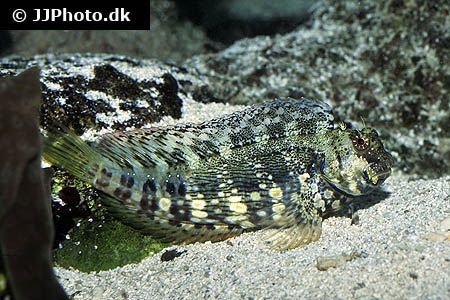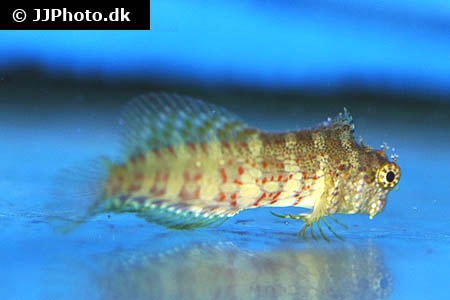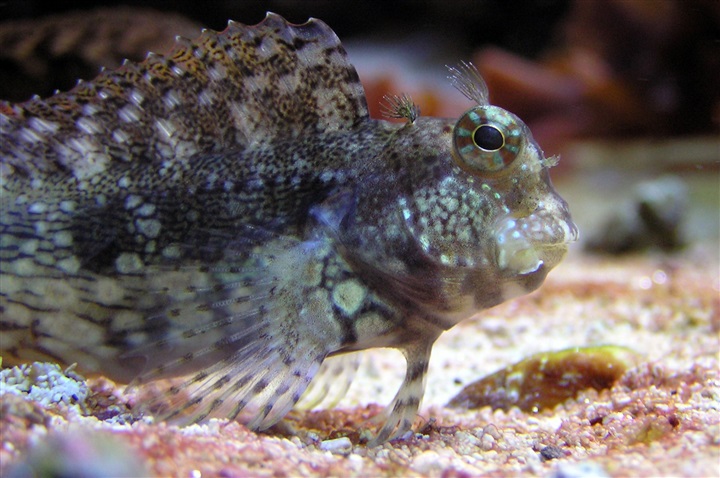Salarias fasciatus
| Latin name | Salarias fasciatus - (Bloch, 1786) |
|---|---|
| Local name | Jewelled blenny |
| Family | Blenniidae - Salarias |
| Origin | East Indian Ocean, West Indian Ocean, Australia, Japan, The Red Sea, Indonesia, East Pacific, Central/West Pacific |
| Max length | 14 cm (5.5") |
| Minimum volume |
400 l (106 gal) |
|---|---|
| Hardiness |
Hardy |
| Suitable for aquarium |
Suitable with care |
| Reef safe |
Always reef safe |
| Aggressiveness | Might be aggressive towards food competitors |
| Recommended |
Microalgea (Eg. spirulina) |
|---|---|
| Maybee |
Macroalgea (Eg. seaweed / nori) |
This species is known to jump out of open aquaria.
This species only eats algae from rocks and glass. There must therefore be enough algae growth so it can find its own food.
Some aquarists have trained it to accept dry foods, but it is not something one should count on.
This species often has a fun and interesting personality.
This species has the ability to change its colouring depending on the surroundings.
This species can eat large amounts of algae (relative to their size) from rocks, like green hair algae and filamentous algae.
As it doesn’t eat every algae type, in case of a specific algae plague, find out more precise information.
Sorry, no translation available.
This fish is also known as Lawnmower Blenny.
Fish in the genus Salarias are often used to combat algae growth, especially the Jewelled Blenny is popular and is seen in many aquaria. There is little difference in what these fish eat, but they often remove the filamentous algal layer and detritus from glass and rock. Some individuals eat also other kinds of algae, like i.e. green hair algae.
Be aware that they can be very aggressive towards other Blennies. Also in some instances towards food competitors, like the Surgeonfish, Rabbitfish or similar.
There are many differences within the Toothcomb Blennies family, some eat algae whilst others eat zooplankton. There are many families of Blennies, this is merely one of them.
What they have in common are their oblong shape and long dorsal fin. Some species have small "legs" used to move around the bottom.
These Blennies do not normally get very big and are therefore a good choice for both small and large aquaria. They are not often very colorful, but many have a fun personality which many aquarists fall for.
The species of the families Aspidontus and Plagiotremus imitate Cleaner Wrasses and can therefore be difficult to identify.
| Aquarium trade | Yes |
|---|---|
| Distribution | Indo-Pacific: Red Sea and East Africa to Samoa, north to the Ryukyu Islands, south to the Great Barrier Reef and New Caledonia. |
| English common names |
Jeweled blenny Jewelled blenny Banded jewelled-blenny |
Salarias fasciatus - Saltvandswiki.dk - (Danish)
Scott Michael. 2013. Über Algae Eaters: The Lawnmower Blennies - Tropical Fish Hobbyist Magazine - (English)
Bob Fenner. Algae-Eating Blennies of the Genera Salarias and Atrosalarias - Wet Web Media - (English)
Jeff Kurtz. 2007. Combtooth Blennies: Bewitching Bottom Dwellers - Tropical Fish Hobbyist - (English)
Scott W. Michael. Reef Aquarium Fishes: 500+ Essential-to-know Species - TFH Publications / Microcosm Ltd. - (English)
Bob Fenner. The True/Combtooth Blennies, Family Blenniidae - Wet Web Media - (English)
Bob Fenner. Blennioids: Blennies and Blenny-Like Fishes - Wet Web Media - (English)




